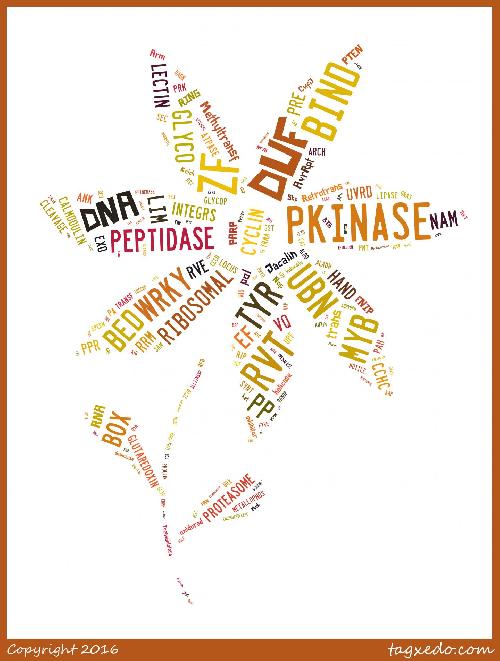Plant health and interaction with microbes is maintained by intricate antennas - plant immune receptors. A certain class of receptors is turning out to be highly informative about plant disease resistance.
A few of such Nucleotide-binding Leucine-Rich Repeat receptors (NLRs) with additional integrated domains that act as 'baits' for the pathogen were previously identified in rice and thale cress, and experimentally shown to be involved in disease resistance. Dr Krasileva and her TSL colleagues searched for these genes across plant species, including the key UK crops: wheat, potatoes and rapeseed.
NLRs are found within the cells, rather than at the cell membrane or in cell walls. When activated by an invasive pathogen or foreign organism, NLRs activate cellular self-destruction - they are sensors of attack. Once a pathogen has infected a plant cell and bound these targets, the cell is likely to self-destruct, blocking pathogen growth before it can reach other cells.
 The 'Wordle' image shows the relative abundance of gene functions 'fished' out of the plant databases using the NLR sequence. All of these genes are potential candidates for disease resistance in plants as they are implicated as targets for plant pathogens. Credit: tagxedo.com - Dr Ksenia Krasileva
The 'Wordle' image shows the relative abundance of gene functions 'fished' out of the plant databases using the NLR sequence. All of these genes are potential candidates for disease resistance in plants as they are implicated as targets for plant pathogens. Credit: tagxedo.com - Dr Ksenia Krasileva
By scanning 40 available plant genome sequences including 19 crop species for the full spectrum of NLRs fused to other plant proteins, the team of scientists evaluated the diversity of such integrations of potential sensor domains across flowering plants. Additional manual analysis of wheat and brassicas validated a subset of fusions in wild and cultivated varieties.
Examining NLR fusions that occur in multiple plant families, the scientists identified that some were prevalent across lineages. The fact that these fusions are common to the majority of surveyed flowering plants is an important discovery in combatting plant disease. The corresponding domains that have been integrated into NLR proteins during evolution likely reveal previously unsuspected targets of pathogen effectors.
Dr Ksenia Krasileva, Lead author of the study and Group Leader at TGAC/TSL, said: "Our method for detecting variations in immune receptors across flowering plants revealed exciting new genes that might be important for plant health. Our findings provide very rich information for scientists who are working to understand how plant immunity works. Similarly, plant breeders might be able to deploy our discoveries to improve sustainable production of each of the crops we analysed. We hope that the NLR-fusions we uncovered will provide clues to the host proteins targeted by pathogens and that this information can be deployed to discover new sources of disease resistance."
Dr Jonathan Jones from TSL, Co-author of the study, said: In the last year, we and others showed that plant NLR immune receptors can carry integrated domains that mimic authentic host targets of pathogen effectors. Interestingly, the identity of such NLR-fusions overlaps significantly with effector targets revealed by other methods, and thus reveal some important new host components that might be targeted by effectors to promote susceptibility. This work this has been a wonderfully productive collaboration between TGAC and TSL, and between the Krasileva and Jones groups."
Dr Panagiotis Sarris from TSL and Exeter University, First author of the study, added: "The latest breakthrough discovery in the evolutionary battle between plants and pathogens is that plant immune receptors carry additional built-in protein areas, which enable them to detect pathogens and activate defence. Our study revealed a great number of extraneous domains. These findings can help us to obtain a better overview of the virulence strategies that pathogenic microbes use to promote susceptibility.
This research, entitled: "Comparative analysis of plant immune receptor architectures uncovers host proteins likely targeted by pathogens" is published in BMC Biology (1).
The project was funded by The Biotechnology and Biological Sciences Research Council (BBSRC) and The Gatsby Charitable Foundation.
TGAC is strategically funded by BBSRC and operates a National Capability to promote the application of genomics and bioinformatics to advance bioscience research and innovation.
source: The Genome Analysis Centre